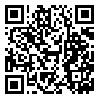Volume 15, Issue 5 (Dec 2021 & Jan 2022)
payavard 2022, 15(5): 490-507 |
Back to browse issues page
Download citation:
BibTeX | RIS | EndNote | Medlars | ProCite | Reference Manager | RefWorks
Send citation to:



BibTeX | RIS | EndNote | Medlars | ProCite | Reference Manager | RefWorks
Send citation to:
Ghazi Saeedi M, Tanhapour M. Telemedicine System: A Mandatory Requirement in Today’s World. payavard 2022; 15 (5) :490-507
URL: http://payavard.tums.ac.ir/article-1-7105-en.html
URL: http://payavard.tums.ac.ir/article-1-7105-en.html
1- Associate Professor, Department of Health Information Management, School of Allied Medical Sciences, Tehran University of Medical Sciences, Tehran, Iran
2- Ph.D. Candidate in Medical Informatics, School of Allied Medical Sciences, Tehran University of Medical Sciences, Tehran, Iran ,m_tanhapour@razi.tums.ac.ir
2- Ph.D. Candidate in Medical Informatics, School of Allied Medical Sciences, Tehran University of Medical Sciences, Tehran, Iran ,
Abstract: (2425 Views)
Background and Aim: Telemedicine provides medical services remotely. There are some problems with implementing telemedicine projects. The purpose of this study was to investigate the most common telemedicine services in Iran and other developed countries as well as examine the legal, financial and privacy challenges of telemedicine services in these countries, especially in the era of the COVID-19 epidemic.
Material and Methods: In this study, the status of telemedicine in Iran and developed countries was reviewed. Thus, related papers and grey literature were retrieved from PubMed, Scopus, SID and Magiran scientific databases. Also, related websites including the Ministry of Health and Medical Education of the Islamic Republic of Iran were examined. According to the study’s purposes, the relevant resources were selected and summarized by researchers.
Results: Radiology, psychiatry and cardiology are the most widely used telemedicine services for interaction with patients as well as emergency, pathology and radiology for healthcare professional communication. Teleconsulting is the most widely used telemedicine service in Iran. There are some laws such as article 74 from section 14 in the Iran development plan to support the provision of e-health and telemedicine services. Also, there are some limited laws for patients’ privacy. In Europe, there is a set of guidelines for health websites, mobile health and cross-border exchange of health information, etc. although there are no uniform laws about telemedicine. HIPAA in the United States and GDPR in Europe are some privacy laws in developed countries. There are some restrictions on telemedicine reimbursement in the United States including the fee-for-service payment model; however, the costs of telemedicine in the United States are usually less than face-to-face treatment.
Conclusion: In the present era using telemedicine services become a requirement due to the outbreaks of epidemics such as COVID-19. Concerning the experience of developed countries, telemedicine services development in Iran requires some considerations in terms of legal, financial and privacy aspects including the creation of explicit laws on patients and healthcare provider’s rights, providing the telemedicine guidelines in different clinical fields such as structured formats for teleconsultation as well as the explicit laws for preserving the patient’s privacy.
Material and Methods: In this study, the status of telemedicine in Iran and developed countries was reviewed. Thus, related papers and grey literature were retrieved from PubMed, Scopus, SID and Magiran scientific databases. Also, related websites including the Ministry of Health and Medical Education of the Islamic Republic of Iran were examined. According to the study’s purposes, the relevant resources were selected and summarized by researchers.
Results: Radiology, psychiatry and cardiology are the most widely used telemedicine services for interaction with patients as well as emergency, pathology and radiology for healthcare professional communication. Teleconsulting is the most widely used telemedicine service in Iran. There are some laws such as article 74 from section 14 in the Iran development plan to support the provision of e-health and telemedicine services. Also, there are some limited laws for patients’ privacy. In Europe, there is a set of guidelines for health websites, mobile health and cross-border exchange of health information, etc. although there are no uniform laws about telemedicine. HIPAA in the United States and GDPR in Europe are some privacy laws in developed countries. There are some restrictions on telemedicine reimbursement in the United States including the fee-for-service payment model; however, the costs of telemedicine in the United States are usually less than face-to-face treatment.
Conclusion: In the present era using telemedicine services become a requirement due to the outbreaks of epidemics such as COVID-19. Concerning the experience of developed countries, telemedicine services development in Iran requires some considerations in terms of legal, financial and privacy aspects including the creation of explicit laws on patients and healthcare provider’s rights, providing the telemedicine guidelines in different clinical fields such as structured formats for teleconsultation as well as the explicit laws for preserving the patient’s privacy.
Send email to the article author
| Rights and permissions | |
 |
This work is licensed under a Creative Commons Attribution-NonCommercial 4.0 International License. |





